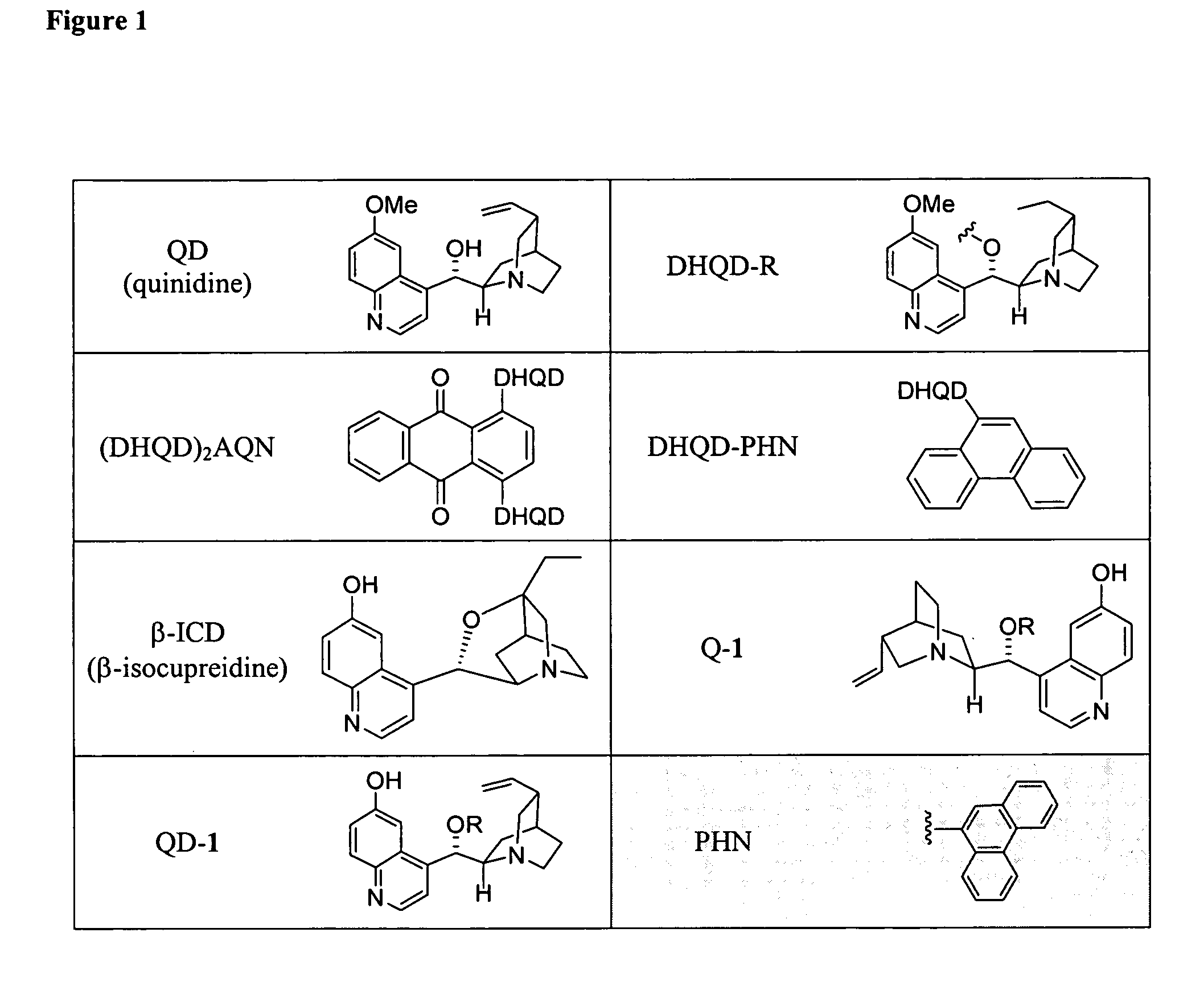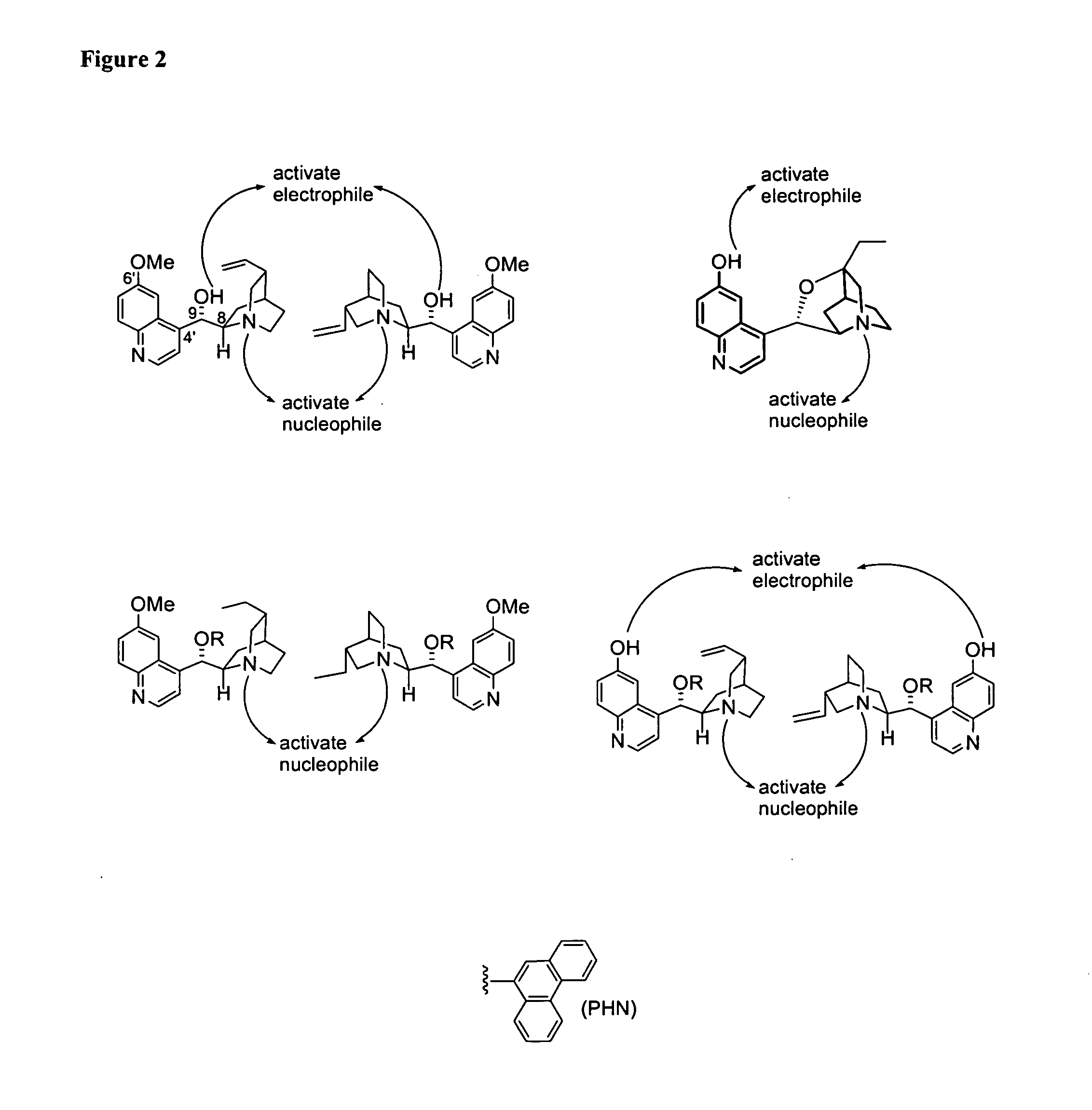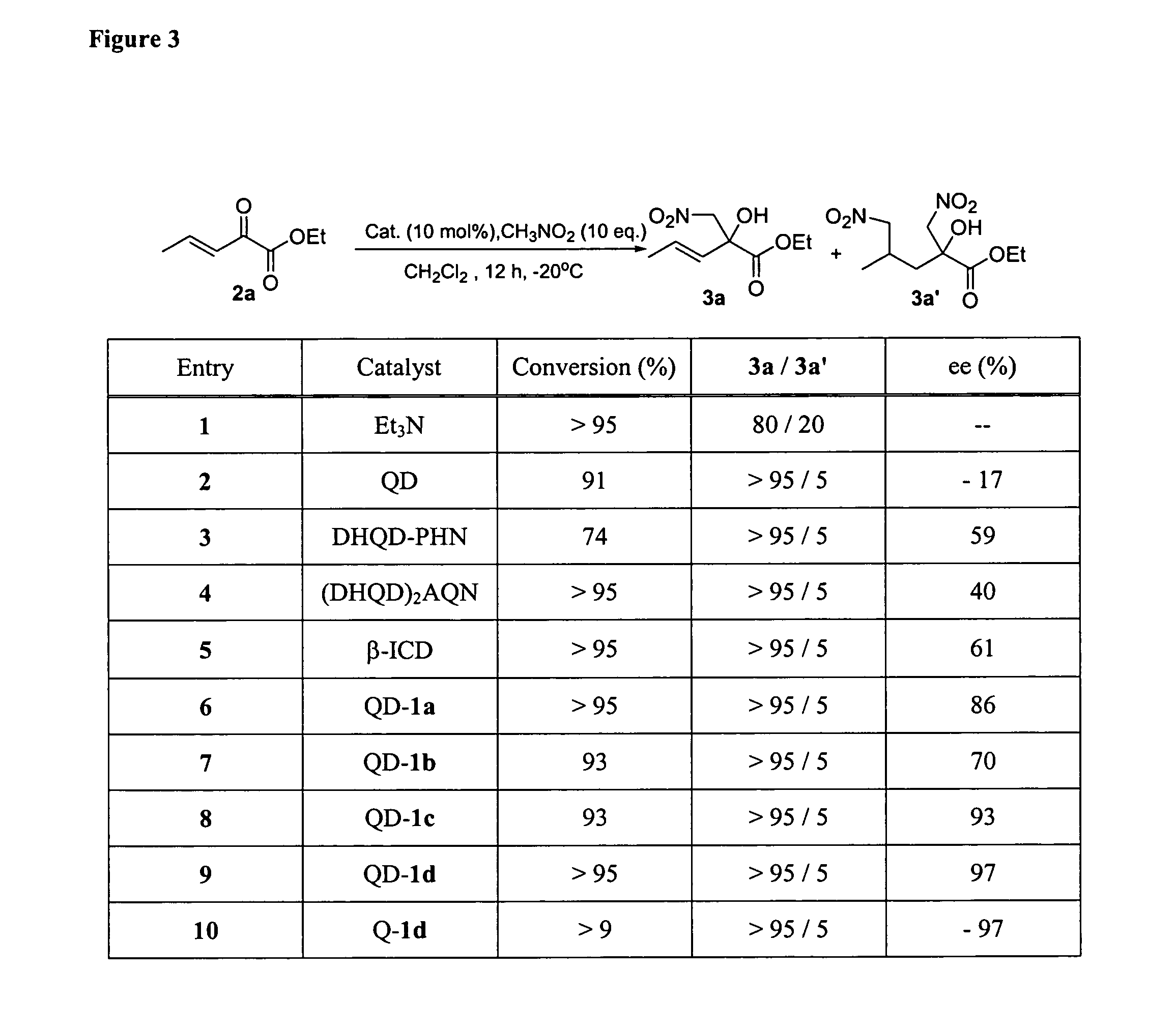Asymmetric aldol additions using bifunctional cinchona-alkaloid-based catalysts
a technology of aldol and cinchonaalkaloid, which is applied in the field of enantiomerically pure compounds, can solve the problems of high cost, inconvenient and time-consuming, and each of these methods has serious drawbacks, and achieves high enantioselectivity, good to excellent yield, and operation. good
- Summary
- Abstract
- Description
- Claims
- Application Information
AI Technical Summary
Benefits of technology
Problems solved by technology
Method used
Image
Examples
example 1
Preparation of Catalyst Q-1d
[0774] A suspension of quinine (3.6 g, 11.46 mmol), NaSEt (90% purity, 5 g, 5 eq.) in anhydrous DMF (60 mL) was heated at 105° C. (oil bath temperature) under N2 for 16 hours. The mixture was cooled to room temperature then pored into sat. NH4Cl aq. (100 mL) and pH of the aqueous phase was around 7. The mixture was extracted with ethyl acetate (2×200 mL). The combined organic phase was washed with aqueous HCl (2N, 4×25 mL) and the combined aqueous phase was treated with ammonium hydroxide (20 mL) and the pH of the aqueous phase is 10-11. The mixture was exacted with ethyl acetate (2×250 mL), and the combined organic phase was washed with brine, dried over anhydrous Na2SO4. The solvent was removed in vacuo and the residue was dissolved in anhydrous DMF (50 mL). At room temperature, TIPSCI (4.6 mL, 2 eq.) was added to the solution, followed by addition of imidazole (1.5 g, 2 eq.). The resulting solution was stirred at room temperature for 4h, when TLC anal...
example 2
Preparation of Catalyst OD-1d
[0776] Following same procedure as described for preparation of Q-2, QD-2 was obtained in 75% yield from quinidine (QD). [α]D25=+137.8 (c 1.0, CHCl3); 1H NMR (400 MHz, CDCl3) δ 8.71 (d, J=5.2 Hz, 1H), 7.87 (d, J=9.2 Hz, 1H), 7.65 (d, J=4.4 Hz, 1H), 7.37 (d, J=2.8 Hz, 1H), 7.20 (dd, J=2.4 Hz, 9.2 Hz, 1H), 6.50 (br, 1H), 6.02-5.93 (m, 1H), 5.22 (d, 3.6 Hz, 1H), 5.19 (d, J=10.4 Hz, 1H), 4.25 (br, 1H), 3.37-3.31 (m, 3H), 3.14-3.08 (m, 1H), 2.54-2.51 (m, 1H), 2.32 (t, J=12.0 Hz, 1H), 1.93-1.86 (m, 2H), 1.68-1.63 (m, 1H), 1.36 (hept. J=7.2 Hz, 3H), 1.13 (d, J=7.2 Hz, 9H), 1.11 (d, J=7.2 Hz, 9H); 1.00-0.90 (m, 1H); 13C NMR (100 MHz, DMSO-d6) δ 154.4, 147.8, 144.1, 143.7, 136.6, 131.3, 125.6, 124.7, 119.0, 117.3, 110.0, 67.3, 60.2, 49.2, 48.7, 37.6, 27.7, 23.6, 18.5, 18.05, 18.01, 12.8; IR (CHCl3) v 3217 (br), 2943, 2867, 1617, 1589, 1504, 1456, 1259; HRMS (CI) m / z calcd. for (C28H42N2O2Si+H+): 467.3094, found: 467.3103.
[0777] Following the same procedure desc...
example 3
Enantioselective Addition of Nitromethane to α-Keto esters (via QD-1d or Q-1d)
[0778] At −20° C., to a solution of α-keto ester 2 (0.5 mmol), nitromethane (5 mmol) in CH2Cl2 (0.5 mL) was added catalyst QD-1d or Q-1d (5 mol %). See FIG. 3. The resulting mixture was kept at the indicated temperature until 2 is completely consumed. The reaction mixture was directly subjected to silica gel flash chromatography using the eluent specified below to afford the desired product in the yields and enantiomeric excess summarized above. The catalyst is recovered in greater than 95% yield by washing the silica gel column with MeOH. The recovered catalyst was identical to that before the reaction by NMR analysis and can be reused without further treatment.
(+)-3a: This product was obtained as a colorless oil in 92% yield after flash chromatography (elution gradient: ethyl acetate / hexane=1 / 15) and 96% ee as determined by HPLC analysis [Daicel chiralpak AD, hexanes:IPA, 90:10, 0.8 mL / min, k 215 nm,...
PUM
 Login to View More
Login to View More Abstract
Description
Claims
Application Information
 Login to View More
Login to View More - R&D
- Intellectual Property
- Life Sciences
- Materials
- Tech Scout
- Unparalleled Data Quality
- Higher Quality Content
- 60% Fewer Hallucinations
Browse by: Latest US Patents, China's latest patents, Technical Efficacy Thesaurus, Application Domain, Technology Topic, Popular Technical Reports.
© 2025 PatSnap. All rights reserved.Legal|Privacy policy|Modern Slavery Act Transparency Statement|Sitemap|About US| Contact US: help@patsnap.com



